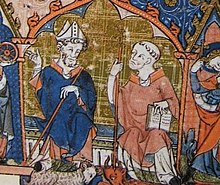
Back اوزوالد من ورسيستر ARZ Svatý Osvald Czech Oswald von York German Oswald de Worcester Esperanto Oswaldo de Worcester Spanish Oswald Worcesterläinen Finnish Oswald de Worcester French Osvaldo di Worcester Italian Oswald van York Dutch Oswald z Worcesteru Polish
Oswald | |
|---|---|
| Archbishop of York | |
 | |
| Appointed | 972 |
| Term ended | 29 February 992 |
| Predecessor | Edwald |
| Successor | Ealdwulf |
| Other post(s) | Bishop of Worcester |
| Orders | |
| Consecration | 961 |
| Personal details | |
| Died | 29 February 992 Worcester |
| Buried | Worcester |
| Sainthood | |
| Feast day | 29 February (leap years)[1]
28 February (common years) 19 May (POCSP) |
| Venerated in | Eastern Orthodox Church[2] Catholic Church Anglican Communion |
Oswald of Worcester (died 29 February 992) was Archbishop of York from 972 to his death in 992. He was of Danish ancestry, but brought up by his uncle, Oda of Canterbury, who sent him to France to the abbey of Fleury to become a monk. After a number of years at Fleury, Oswald returned to England at the request of his uncle, who died before Oswald returned. With his uncle's death, Oswald needed a patron and turned to another kinsman, Oskytel, who had recently become Archbishop of York. His activity for Oskytel attracted the notice of Archbishop Dunstan who had Oswald consecrated as Bishop of Worcester in 961. In 972, Oswald was promoted to the see of York, although he continued to hold Worcester also.
As bishop and archbishop, Oswald was a supporter and one of the leading promoters (together with Æthelwold) of Dunstan's reforms of the church, including monastic reforms.[3] Oswald founded a number of monasteries, including Ramsey Abbey, and reformed another seven, including Winchcombe in Gloucestershire and Pershore and Evesham in Worcestershire. Oswald also switched the cathedral chapter of Worcester from secular clergy to monks. While archbishop, he brought the scholar Abbo of Fleury to teach, and he spent two years in England, mostly at Ramsey. Oswald died in 992, while washing the feet of the poor. A hagiographical life was written shortly after his death, and he was quickly hailed as a saint.
- ^ "FEBRUARY 29 BUSY Saint Oswald of Worcester A.D. 925–992". Today’s Saint. The Dynamic Catholic Institute. Archived from the original on 29 February 2024. Retrieved 29 February 2024.
- ^ Lapa, Dmitry (13 March 2016). "Holy Hierarch Oswald, Bishop of Worcester and Archbishop of York". OrthoChristian. Retrieved 25 September 2024.
- ^ Lawrence Medieval Monasticism p. 101